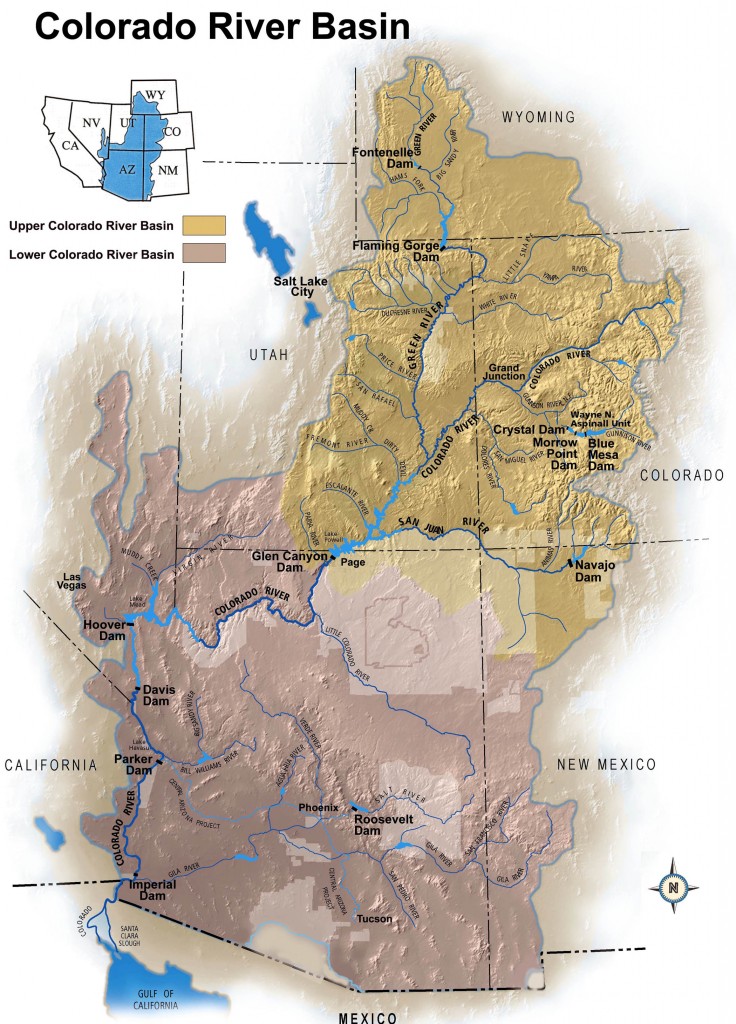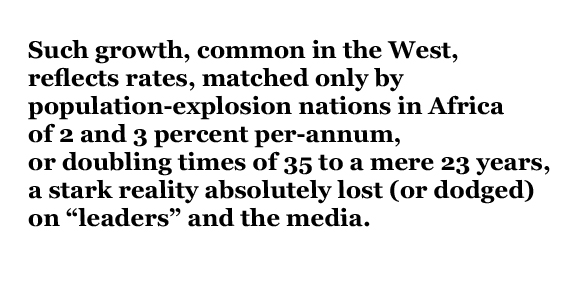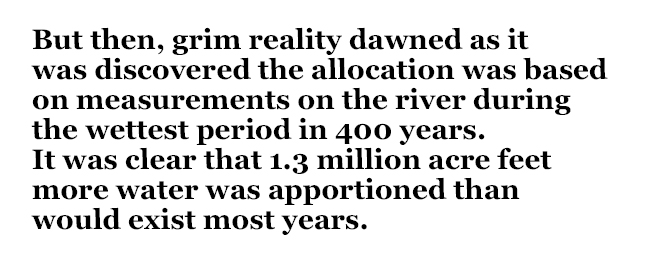I was going to write about population, water and the Southwest, largely where I’m still headed. But then came headlines about the Occupy Movement; an essay on the Cassandra dilemma, and my ongoing frustration that a nation founded on the core concept of majority rule today has none, why—although the fact is little recognized—we are paralyzed on critical issues.
The founders fought the Revolutionary War to end “the tyranny of the few over the many,” sadly, pretty much the system we have devolved into. We no longer have the “few” of English royalty, but we have the few of powerful lobbyists and campaign contributors.
Elected officials were, once upon a time, obligated to vote in a way that represented the wishes of the majority of those they, well, represented—that in a time when an angry constituency might happily resort to tarring and feathering.
Our minority-rule system today is predicated on:
- elected officials’ seemingly unbreakable ties to campaign-finance sources (the few)
- their exclusive focus on critical voting blocs (the few), rather than the majority
- a preoccupation with the next “election cycle,” rather than the long-term good of the nation
- catering to the overly powerful “elites” (the few) that the Occupy Movement rightly condemn
- as CBS News revealed on “60 Minutes,” outright Congressional corruption.
The news program showed how the only people who can do insider trading legally are members of Congress. Curiously, after “60 Minutes” broke the story, a bill to correct the problem, which had languished for lack of sponsors, was suddenly awash in them, as an outraged Nancy Pelosi and John Boehner could do little more than bluster during “60 Minutes” interviews about their possible enrichment as a result of insider trading.
I recently read “The Quiet Coup,” (The Atlantic, May 2009) by a former chief economist at the International Monetary Fund stating that if the United States needed a loan from that organization—often a last resort for developing nations—it would be denied for the same reason that many developing nations are: corruption! The problem, from author Simon Johnson’s view, is that the finance industry has “effectively captured our government,” with him defining how recovery will fail unless we break the financial oligarchy that blocks reform.
Congress focuses solely on economic issues even as it ignores environmental, education, health-care, infrastructure, and other critical crises—without realizing that those are all the very foundations of long-term economic well-being and, certainly, the ability of all systems to evolve and adapt to a changing world.
Now, to the Cassandra dilemma. I receive daily—and, to me, critical—emails from Population Media. Much of their work targets women in developing nations. These include family-planning messages and progressive role models featured in radio and television soap operas. Their emails, available upon request at www.populationmedia.org/who/subscribe-to-pmc / , are gathered from news sources and professionals around the world and are about population, global warming, species extinctions, agriculture, biodiversity, water and women’s issues, such as the recent, “The men behind the war on women,” about the influence of the U.S. Conference of Catholic Bishops (the few) on Congress.
The nation’s nearly 70 million Catholics—nearly one-in-four Americans—deserve representation, but the essay indicates that even Catholics go unrepresented. One 2008 poll showed that 98 percent of sexually active Catholic women use birth control, 83 percent of those who attend mass weekly. A Pew poll showed that only 21 percent believe abortion should be illegal, while 59,000 nuns sent a letter to Congress in 2010 urging the passage of healthcare reform, despite the bishops’ opposition because the bill would allow federal subsidy of abortions. We got another example of this recently when a right-to-life effort in Mississippi was turned down resoundingly by voters, illustrating, if nothing else, that far-right religious voters might not be as many or as extreme as depicted in the media. Yet, this is an example of how the few hold sway over the many.
Another recent Population Media transmission was an essay by Kurt Dahl about the Cassandra dilemma. Cassandra was the beautiful daughter of royalty from ancient Troy. The god, Apollo, fell in love with her and bestowed upon her the ability to know the future. But when she refused him, he cursed her by making it so that no one would believe her predictions, as Dahl wrote, “a frustrating curse in the extreme,” as she tried, in vain, to warn of the danger of the Trojan horse.
Dahl then says this is where we are today. Many see the looming dangers of climate disruption, peak oil, water depletion, soil degradation, species extinction, and human population growth and fear a disaster, as Dahl writes, “of unimaginable proportions.” Yet, we get no action to address those problems even though there could be only a small window of opportunity.
Dahl attributes this to apathy, denial and false hope, certainly true. But I think it also harkens back to “the tyranny of the few over the many.” Even if most Americans are concerned about climate disruption, (I believe most are), we have nowhere to go for representation—certainly not elected officials whose purse strings are held by powerful energy lobbies, who see not an opportunity in fighting climate disruption but an obstacle. That is tragic, since China sees that opportunity and has captured the market in solar technologies, with fog-bound Germany close behind. As clearly defined in Tom Friedman’s Hot, Flat and Crowded, a nation that grew based on innovation is no longer innovative nor willing to change outdated utility regulations—the few again.
Now to water and the American Southwest. It is telling that the first online comment about a January 2012 Scientific American article about an impending water crisis in the Southwest—of perhaps catastrophic proportions—read, “…those who follow U.S. politics will immediately recognize that nothing will happen until a crisis is undeniable, and probably not even then.” That’s cynical, but accurate because water is another issue where we have no representation, although another hurdle is that 99 percent of the people have no clue where their water comes from or how vulnerable the supply.
Scientists have long cautioned that the Southwest would be hit first, worst and hardest by climate disruption, but more troubling is what could happen if the Southwest simply returns to the usual far drier norms.
Key is that our “leaders” (a term I always use now with quotes) are moving forward on growth on the assumption that precipitation levels from 1960 to 1995 were the norm, but tree-ring and other research refute that.
Stark reality lost on just about everyone in the Southwest is that the region has been drier—often much, much, much drier—with a number of catastrophic, sometimes civilization-breaking droughts dotting its history, such as one that turned the prehistoric Hohokum’s amazing irrigation system at today’s Phoenix to dust, triggering famine.
Recent years, 2000, 2002 and 2011 brought droughts to the Southwest, each triggering massive tree die offs and wildfires of biblical proportions, such as this year’s Wallow Fire in Arizona and the Las Conchas Fire—visible at night as an eerie ghost fire smoldering across miles of mountain side after its first catastrophic blowup. The Wallow burned over 800 square miles (half-a-million acres) and the Las Conchas burned over 150,000 acres. For perspective, the 1996 Dome Fire, at the time the largest wildfire in state history, burned a mere 16,600 acres!
Yet, these “droughts,” including the infamous 1930s drought or the “Fifties drought,” when placed in the context of Southwestern history, barely show as droughts!
Key is that the 20th century was the wettest century in nearly 2,000 years.
A 40-year drought in the mid-1500s hit much of the continent, but most especially the Southwest. As one climatologist commented, “There’s no way that large human populations would be able to live (in the Southwest) in that. It was not a good time.”
commented, “There’s no way that large human populations would be able to live (in the Southwest) in that. It was not a good time.”
And, severe droughts occurred in the late 1300s, contributing to the abandonment of cities in the Four Corners area. Drought dominated much of the 1400s and the mid-1700s. A 1680s drought was worse than the 1950s drought and helped trigger the successful uprising against Spaniards by the Pueblos in New Mexico who had been forced to turn over most of their harvests to their captors.
Such mega-droughts were likely triggered by routine temperature changes in the Atlantic and Pacific, part of normal Southwest weather trends—trends likely to grow more extreme with global warming.
On other side of the coin—the one we humans have control over—is that the region is the fastest growing region of this the world’s third most populated nation, behind only China and India.
As I argued in a recent paper for the Center for Immigration Studies (http://www.cis.org/southwest-water-population-growth) , there is insufficient water for the current population, as “leaders” operate on the assumption that the astronomically high growth of the past century must (apparently, solely for economic reasons) continue, even as Phoenix is larger in physical size that Paris, San Francisco, Chicago and Washington, D.C., combined with the greater Salt River Valley at over 4 million people, up from a paltry 5,554 citizens in 1900. Las Vegas is over 2 million, up from 2,000 in 1920, a thousand-fold increase in less than 100 years, a story common or exceeded in every major Southwestern city. Denver, at over 2.5 million, up from 130,000 in 1900, is on the Atlantic watershed—where the Colorado’s waters were never meant to flow—but dependent upon Colorado River water diverted under or over the Rocky Mountains, an illustration of the adage that in the West, “Water flows uphill towards money.”
Such growth, common in the West, reflects rates, matched only by population-explosion nations in Africa of 2 and 3 percent per-annum, or doubling times of 35 to a mere 23 years, a stark reality absolutely lost (or dodged) on “leaders” and the media.
The Colorado is the only major river in the region, since, as 20th Century humorist Will Rogers summed up, the only other “big” river, the Rio Grande, is the only river he had seen that “looked like it needed to be irrigated,” plus it too is over-allocated, improperly used and increasingly challenged by drought.
In the 1920s, the Colorado was legally apportioned, or divided, to the upper-basin states (Colorado, Utah, Wyoming and New Mexico) and the lower-basin states (Arizona, Nevada, California) on the assumption the river carried 16.4 million acre-feet a year, with 7.5 million acre feet allocated to each basin and the “excess” promised to Mexico.
But then, grim reality dawned as it was discovered the allocation was based on measurements on the river during the wettest period in 400 years. It was clear that 1.3 million acre feet more water was apportioned than would exist most years.
After tree-ring studies in the late 20th century, an even grimmer reality dawned: the flow will likely be 3 million acre feet less than allocated, something of not-great concern in 1950 when fewer than 15 million people lived in the Southwest, but a serious problem today as the population stands at 60 million on its way to a projected—land-development interests would argue a “hoped-for”—doubling late century. Stream-gage readings have averaged only 14.2 million acre feet per year since 1950, despite it being the dampest period in discernible history.
The Colorado could well average only about 13.5 million acre-feet a year, a stark reality become clearer in the mid-1990s as drier norms returned and reservoir levels plummeted—even as the region’s already booming population really began to explode, part of national demographics linked to births (40 percent of growth) and immigration (60 percent), with the high birth-rate among first-generation immigrants also part of the “birth” number. Key is that, while few things influence outcomes more than our sheer numbers, “leaders” are continuing policies influencing demographics—such as the highest immigration in our nation’s history by a factor of five, higher even than during the Frontier Era “Great Wave”—with no acknowledgement or discussion of the implications to problems like the water shortfalls in the now highly populated Southwest.
Scientific and other voices warn that that shortfall is dangerous, even if global warming is not taken into account, since population increases make the entire water system more “brittle” and likely to respond more quickly and more negatively to drought. At the least, water shortfalls will increase political instability. Nevada recently threatened, for example, to break the very core of all water management in the Southwest, the Colorado River Compact, based on shortfalls linked to its mushrooming population and drought and what it saw as an unwillingness of other interests to hear its concerns.
The Scripps Institute of Oceanography has warned—based on a study that bent over backwards to err on the side of caution—that Lake Mead, the largest reservoir in the nation, by the 2020s could run dry. Others have raised concerns about the second largest reservoir, Lake Powell, with the U.S. Bureau of Reclamation conceding, partly due to water-management changes implemented to try to ameliorate the crisis on the Colorado, that Lake Powell will likely never reach the full-line again.
Critical is that these massive reservoirs are the water core upon which the economy and civilization of the Southwest is built.
Other agencies—the National Academy of Sciences, the Pacific Institute, the University of Colorado’s Western Water Assessment—have similarly raised concerns. A National Academy’s statement, after a 2007 study, said, “It became clear that a broad understanding of the Colorado River management issues is not possible unless both water supply and water demand issues are adequately studied. Our report presents population growth data for much of the western United States that is served by Colorado River water. The cities in the region are collectively the fastest growing in the nation. Of further concern is that growth seems to be occurring with little regard to long-term availability of future water supplies. (Emphasis added.)
Yet, virtually every approach by “leaders” to the crisis—those who even acknowledge it—is only on the “supply side,” or how to find more water, stretch available supplies, or to turn to “techno fixes,” like de-salting, that will only marginally increase supplies or are energy intensive at a time when energy is also an increasing problem, as defined in a recent Sandia National Laboratory study.
Meanwhile, they focus exclusively, to total preoccupation, on attracting more growth to our already fast-growing region—this as they serve “the few,” powerful economic forces dependent upon continued high population growth, especially developers.
That type of “tyranny of the few over the many” is particularly dangerous if it means a potentially dangerous water crisis is not addressed in a common-sense, all-inclusive—demand side and supply side—way, or if national policies affecting growth are never discussed or their demographic implications considered.
(Parker, who lives near Albuquerque, is a fifth-generation native of the American Southwest, and has worked as a journalist covering Los Alamos National Laboratory and the Jemez Mountain region for the Santa Fe New Mexican. She has also worked and written about water issues, forestry issues and population, regionally and nationally.)
To read the PDF version of this article, click here. and here.
Don’t forget our loyal Backbone members!








Water addiction, cocaine addiction, how different are they? Since I work a good deal with the latter, I’ll tell you that any sober, detailed description of a cocaine addict’s way of life reveals how crazy it is. Yet to the addict himself, it seems normal. THAT’S what’s weird! When I read Kathleene’s fine, sobering story about water and growth in the Southwest that feeling of weirdness comes right off the page.
I like the idea of happily resorting to tar and feathering.
[…] “Water” We Gonna Do? Political Deadlock & the West’s Coming Mega-Drought…… […]